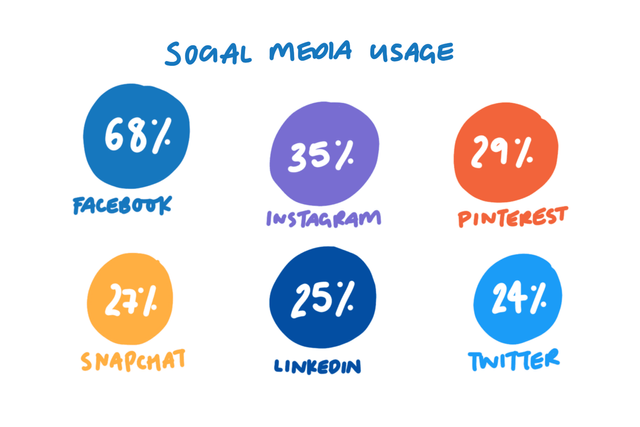How to Use Social Media For Business
It’s hard to find a business that doesn’t utilize at least one social media platform to market their business.

Since we don’t have to convince you why it’s important to use social media as an creator (because you already know), we can spend our time explaining how to use social media get the most out of every platform.
How to use social media for business
Anyone from a top CEO to a recent college graduate can use social media to freely share their ideas and give an inside look into what they’re working on. It’s also a place to engage in conversations that are relevant to your interests or industry.
Bloggers use social media to increase their blog traffic, connect with readers, share valuable content, and build diversified streams of income.
Business owners and larger organizations use social media to connect the people behind their logo with their customer base. They also use it for completing customer service requests while ensuring every follower has a positive experience with the brand.
Since small businesses and Fortune 500 companies can be found on social media, it begs the question why many of us don’t have a marketing strategy in place for each platform. Some of us don’t even know why we’re interacting on the platforms we’re on.
Instead of feeling like you put a lot of time and effort into platforms that you aren’t seeing a return on, we want to help you define a specific purpose for each platform and determine if it’s the right fit for your blog or business.
In order to do that, we have to start by understanding what your main goals are.
 Goal: Increase your engagement
Goal: Increase your engagement
You’ve probably heard the word “engagement” tossed around, but what does it actually mean? Engagement refers to a user’s interaction with your content. The more engaging and memorable your content is, the more people will interact with it.
Engagement is more important than what we call “vanity metrics” like follower count and overall reach. While it’s nice to see your visibility increase, engagement shows the number of people who are interested enough in what you have to say to spend time with your content and share their thoughts.
With each new algorithm update, it seems as though it is harder to get engagement. This is because social media platforms prioritize content that the user interacts most with as well as advertised content you pay for. This is why it’s more important than ever to encourage your followers to interact with your content. Only then can you continue to pop up and be seen in their news feed.
Increasing your engagement could look like getting more replies on Instagram or more video shares on Facebook. You’ll want to choose which metrics are most important to your business depending on your engagement goals.
 Goal: Increase your traffic
Goal: Increase your traffic
Whenever we talk about increasing your blog or website traffic, our users perk up. Many of us depend on traffic to drive leads or sales. Because of this, increasing your traffic can also be an important social media goal.
Social media can be a main traffic source for many ConvertKit users. Pinterest has been known to drive significant blog traffic since their platform acts more like a search engine than a traditional social media tool. Facebook ads can also drive high quality traffic since you are able to create hyper-targeted advertising campaigns for virtually any goal.
While increasing your traffic is great, it’s usually just the start of reaching your overall business goals. Websites that generate advertising revenue may focus solely on traffic but most entrepreneurs know that it’s only one part of a bigger marketing equation.
It’s not enough just to increase the number of people who are visiting your website. You want your content to be seen by the right people because only the most interested users will convert, which brings us to our next big social media goal.
 Goal: Increase your sales
Goal: Increase your sales
If you treat your blog like a business or run a small business of your own, increasing your sales will most likely be one of your top goals. How many sales can you directly earn from social media, and how do you attract potential buyers from each platform? These are questions that help us understand how to increase our conversions through social media.
Using social media to drive sales can feel a little like taking the training wheels off your bike when you start using social media to drive sales, but the more you share your offers, the more you’ll see what resonates with your audience. We recommend tracking your performance and keeping an eye on your analytics to see what works best.
Increasing your sales won’t happen overnight. You have to play the long game. If you go from all value-based content to a never-ending stream of advertisements, you’ll turn your audience off. Instead, start by introducing conversion-based content every few posts and look at your engagement to see if (or how) it’s affected.
 Goal: Share valuable content
Goal: Share valuable content
In the debate between quality vs. quantity of content, it will always be more important to produce quality content. Social media is already a noisy place so focusing on creating quality text posts, images, and videos will help you stand out.
If you’re not sure what is deemed “valuable” in the eyes of your audience, take some extra time to survey your audience before you dive into crafting your content strategy.
Does your audience like pinning well-designed infographics to their Pinterest board to refer back to at a later date, or would they rather consume a video tutorial in one sitting? Do they like reading case studies of work you’ve created with your clients, or would your audience members rather watch a video testimonial?
You may be surprised at what your online community finds valuable. You never know until you ask! Once you receive their answers, you can use them to influence what social media platforms you’ll focus on.
Goal: Complete customer service requests
Relationships are a two way street and it’s no different in social media. It’s not enough to just post relevant content for your brand. You must also take the time to thoughtfully engage with your prospective and current customers.
Engaging with your followers becomes even more important when they have a customer service question or complaint. Research has found that 55% of customers have used social media as a tool to complain about brands. If you don’t have an active presence on social media, you might miss their complaints completely and lose out on a loyal customer.
More companies are using social media as a way to address customer questions and concerns directly. Platforms like Facebook have made answering customer questions easier than ever with their private Messenger platform among other features. Other social media platforms will follow suit.
I have my social media marketing goal… now what?
After choosing your goal, you can begin to assess which social media platforms are the best fit for your online business. The first step is to understand where your audience already hangs out. It’s much easier to capture their attention on a platform they are already using rather than trying to convince them to use a new tool.

Once you understand where your ideal clients or customers like to spend their time, you can determine what content types fit well with your brand. If your audience loves live video, Facebook and Snapchat could be a great fit. If your audience would rather read blog posts in their own time, Pinterest might be a better option.
@justjohny resteem done and 75+ vote got from @abir97
Thank you for using our service.